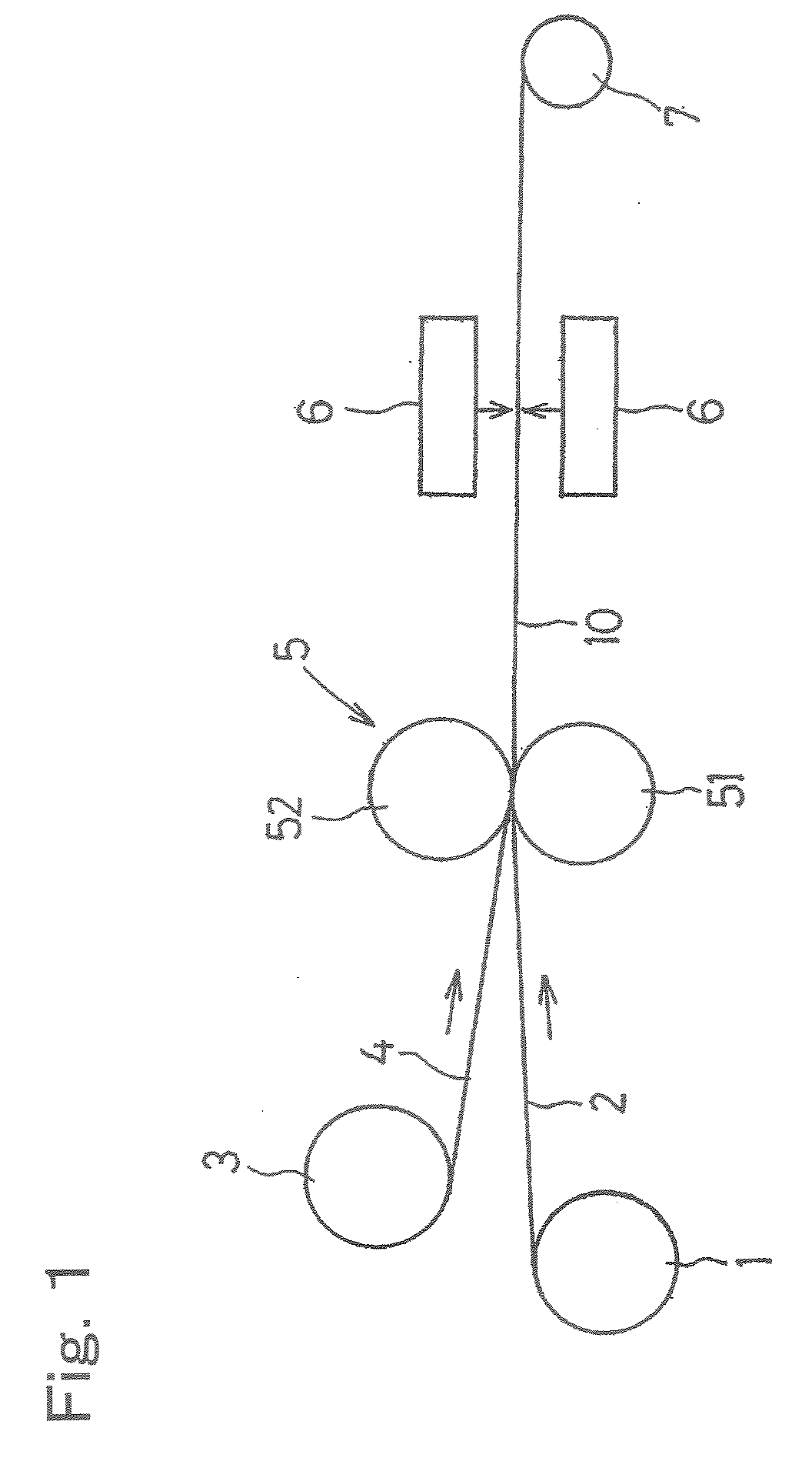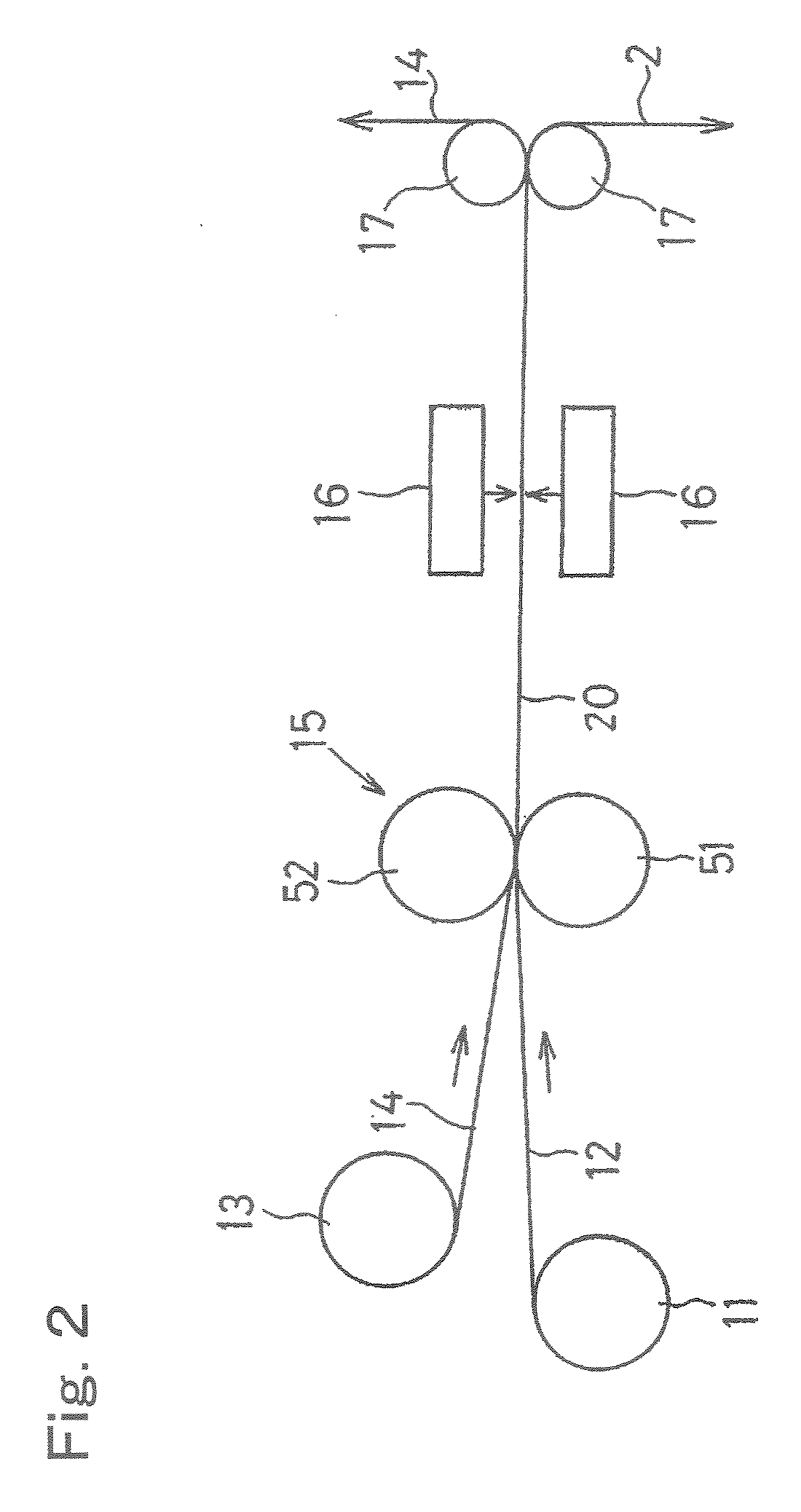Metal-Clad Laminate And Method For Production Thereof
a metal-clad laminate and metal-clad technology, applied in the field of metal-clad laminate, can solve the problems of difficult continuous and stable production, difficult to provide excellent isotropy and dimensional stability of metal-clad laminate, etc., and achieve improve the dimensional stability of thermoplastic liquid crystal polymer film, excellent isotropy and dimensional stability
- Summary
- Abstract
- Description
- Claims
- Application Information
AI Technical Summary
Benefits of technology
Problems solved by technology
Method used
Image
Examples
reference example 1
[0040]A thermoplastic liquid crystal polymer, which was a copolymer of p-hydroxy benzoic acid and 6-hydroxy-2-naphthoic acid and had a melting point of 280° C. was melt-extruded and was then formed into films, having respective film thicknesses of 25, 50, 100 and 225 μm, by an inflation molding method under a condition in which the ratio of drawing in longitudinal and transverse directions was controlled. Each of those resultant films, after having been overlapped with a respective aluminum foil which had a film thickness of 30 μm and was applied thereon with a mold releasing agent, was thermally compressed to bond to the metallic foil by passing them through a nipping region between a metallic heating roll of 260° C. and a heat resistant rubber roll under a pressure of 20 kg / cm2, and was subsequently heat treated for 30 seconds in a heating furnace, which had been heated to a temperature required for the coefficient of thermal expansion αL of each of those films having the differen...
reference example 2
[0042]A thermoplastic liquid crystal polymer, which was a copolymer of p-hydroxy benzoic acid and 6-hydroxy-2-naphthoic acid and had a melting point of 280° C. was melt-extruded and was then formed into films, having respective film thicknesses of 25, 50, 100 and 225 μm, by an inflation molding method under a condition, in which the ratio of drawing in longitudinal and transverse directions was controlled. Each of those resultant films, after having been overlapped with a respective aluminum foil which had a film thickness of 30 μm and was applied thereon with a mold releasing agent, was thermally compressed to bond to the aluminum foil by passing them through a nipping region between a metallic heating roll of 260° C. and a heat resistant rubber roll under a pressure of 20 kg / cm2, and was subsequently heat treated for 30 seconds in a heating furnace, which had been heated to a temperature required for the coefficient of thermal expansion αL of each of those films of the different f...
reference example 3
[0044]A thermoplastic liquid crystal polymer, which was a copolymer of p-hydroxy benzoic acid and 6-hydroxy-2-naphthoic acid and had a melting point of 280° C. was melt-extruded and was then formed into films, having respective film thicknesses of 25, 50, 100 and 225 μm, by an inflation molding method under a condition, in which the ratio of drawing in longitudinal and transverse directions was controlled. Each of those resultant films, after having been overlapped with a respective aluminum foil which had a film thickness of 30 μm and was applied thereon with a mold releasing agent, was thermally compressed to bond to the aluminum foil by passing them through a nipping region between a metallic heating roll of 260° C. and a heat resistant rubber roll under a pressure of 20 kg / cm2, and was subsequently heat treated for 30 seconds in a heating furnace, which had been heated to a temperature required for the coefficient of thermal expansion αL of each of those films of the different f...
PUM
| Property | Measurement | Unit |
|---|---|---|
| thickness | aaaaa | aaaaa |
| melting point | aaaaa | aaaaa |
| melting point | aaaaa | aaaaa |
Abstract
Description
Claims
Application Information
 Login to View More
Login to View More - R&D
- Intellectual Property
- Life Sciences
- Materials
- Tech Scout
- Unparalleled Data Quality
- Higher Quality Content
- 60% Fewer Hallucinations
Browse by: Latest US Patents, China's latest patents, Technical Efficacy Thesaurus, Application Domain, Technology Topic, Popular Technical Reports.
© 2025 PatSnap. All rights reserved.Legal|Privacy policy|Modern Slavery Act Transparency Statement|Sitemap|About US| Contact US: help@patsnap.com



